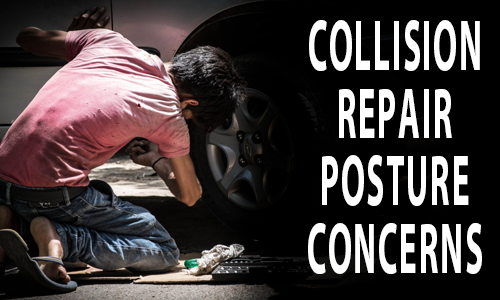Toronto, Ontario — Sept. 30, 2019 — Back pain continues to take a serious toll on Canadian workers both outside and in the collision repair industry. Taking a professional and social effect on a worker’s wellbeing, acute and chronic back pain is treated, but rarely cured after it occurs.
A six-month study found that five in 10 Canadians suffered from Lower Back Pain (LBP). In fact, according to Stats Canada, up to 85 percent of workers in Canada can expect to experience LBP at some point in their life.
“Generally, symptoms of neck and back pain include pain that varies in intensity, at times described as ‘unbearable,’” writes Stats Canada.
Now more than ever, repairers should be reminded of beneficial work habits to practice in order to maintain their core strength.
Although no specific cause can be found within 85 to 90 percent of individuals who suffer from LBP, there are steps that can be taken to prevent or narrow the contributing factors. In a collision repair facility, the two leading culprits of LBP are poor postures when both standing and sitting in addition to improper lifting techniques.
Collision repair staff have a tendency to hunch over vehicles for long periods of time whether it be to assess damages, or maybe to remove and replace a part. Step stools and better vantage points, in general, can mitigate or even eliminate the risk of contortion.
Sitting posture is almost another matter entirely for those working in our industry. There are times where chairs are unable to compensate for how low a repairman needs to be able to reach the lower portions of a vehicle. Rather than crouching for long periods of time, experts recommend workers sit with their backs straight and legs hip-distance apart. If a low-to-the-ground chair is suitable, it should provide proper back support with the worker changing their sitting position often. Another useful tip is to take occasional walks around the shop, simply to remobilize a worker’s body and prevent muscle tension build-up.
The last and most contributing factor to LBP in collision repair workers is heavy or improper lifting techniques. Most workers are trained to lift objects with straight backs, bent knees and slow, sturdy motion. What is rarely practised, however, is to ask for assistance during heavy lifting scenarios. Most workers are preferring to get the lift over and done with, regardless of whether the object might be too heavy for them. This does not only take its toll on the spinal health of the worker, but it also heightens the risk of a drop or fall, which — needless to say — can become serious quickly. When it comes to a repair job, it should never be a question of pride vs safety. Repairmen of all seniorities should be asking for lifting help when needed.
While lifestyle factors such as smoking, and obesity, also play a role in LBP occurrence and severity, the responsibility of positive workplace habits for repairers and technicians cannot be ignored. The overall effectiveness and health of a repair team depend on it.





































